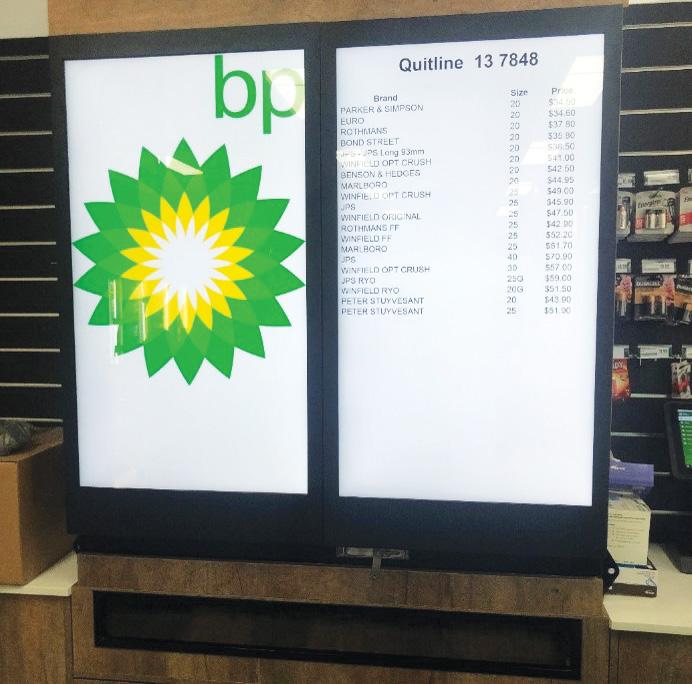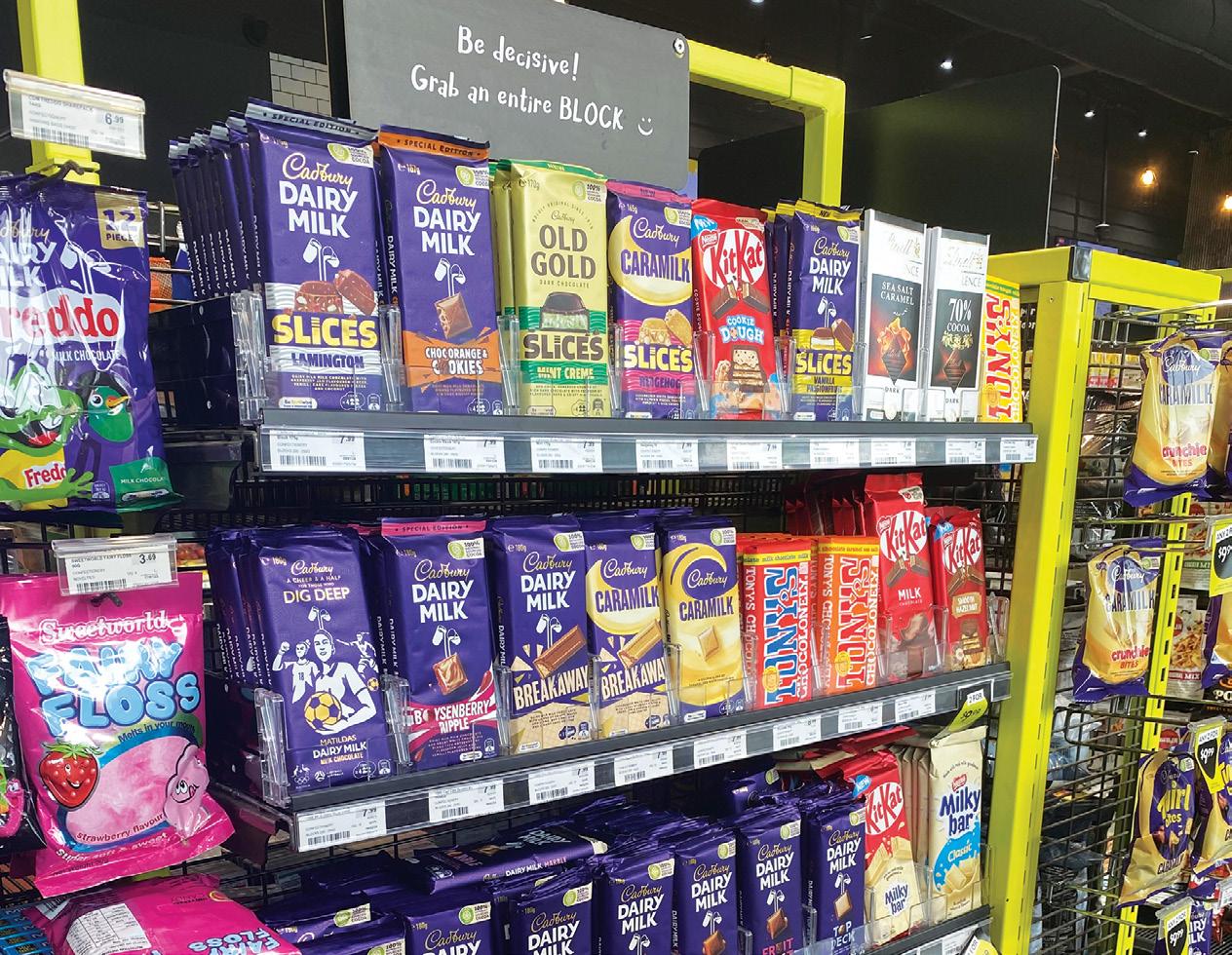
9 minute read
FEATURE: IN STORE TECHNOLOGY
Tech takes the wheel
Cutting edge technologies are emerging as key drivers of competitive advantage, transforming customer experiences, operational efficiency, and security in P&C retail.
Words Deb Jackson
IN THE RAPIDLY evolving retail landscape, petrol and convenience stores are harnessing cutting-edge technologies to gain a competitive edge. According to Theo Foukkare, CEO of the Australian Association of Convenience Stores (AACS), the adoption of these technologies is a strategic response to the challenges of shifting consumer behaviours, escalating operational costs, and the constant demand for improved efficiency.
A strategic advantage
Generative AI is a cutting-edge form of artificial intelligence (AI) that is revolutionising industries, offering significant benefits for petrol and convenience retailers. The recent Microsoft report, ‘Australia’s Gen-AI Opportunity,’ highlights several advantages of integrating this technology into retail operations.
One of the primary benefits of Generative AI is its ability to personalise customer experiences. By analysing extensive data, AI can generate tailored recommendations and promotional offers. For P&C retailers, this means crafting highly personalised marketing strategies that resonate with individual preferences and shopping behaviours. Real-time, customised offers based on past purchases and current trends enhance customer satisfaction, drive sales, and build brand loyalty.
Generative AI also transforms inventory management. By predicting demand patterns and generating accurate forecasts, AI tools help retailers optimise inventory levels, reduce waste, and ensure popular products are consistently available.

In addition, AI enhances operational efficiency through automation. Routine tasks such as managing stock levels, processing transactions, and handling customer enquiries can be automated, allowing staff to focus on more strategic activities. AI-powered chatbots, for example, can manage customer queries and provide information on promotions, freeing human resources for tasks that add greater value.
Furthermore, Generative AI aids in product development and innovation by analysing market trends and consumer preferences. This enables retailers to identify new product opportunities and design offerings that meet emerging customer needs. Additionally, AI can generate creative marketing content, speeding up content creation and ensuring consistent, highquality promotional materials.
Successful AI adoption requires strategic planning, infrastructure investment, and attention to ethical considerations like data privacy. Embracing Generative AI allows convenience retailers to achieve enhanced personalisation, efficient inventory management, streamlined operations, and innovative marketing strategies, providing a competitive edge in a dynamic retail landscape.
Our suite of digital signage products makes it faster and easier to deploy messaging across multiple sites in a more impactful way.
- Anthony Irwin, Fujifilm Australia.
This is the case for APCO Service Stations, with Technology Senior Manager Gabriela Machado explaining how technology has streamlined their operations.
“Our technological edge in the P&C retail sector is driven by a suite of advanced solutions that elevate both customer convenience and operational efficiency. We use integrated systems to simplify transactions and gather actionable insights, driving smarter business decisions,” she says.
“The integrated POS systems keep our operations running smoothly, helping customers get back to their day swiftly. The APCO app is a game-changer for quick fuelling, customers don’t even have to step in-store to pay and it’s also making things easier in our Café 24-7 when ordering ahead. We’re also building the foundations to our loyalty program. We know how busy life is, for APCO it’s all about making the customer’s visit as quick and pleasant as possible.”
Digital media opportunities
In-store digital media is increasingly used to deliver tailored promotional messages. As Foukkare points out: “Digital media allows retailers to adjust promotions based on the time of day or specific customer segments without printing new materials. Additionally, digital price ticketing is gaining momentum due to its potential for dynamic pricing and reduced labour costs associated with updating price tags.”
Anthony Irwin, Product Manager, Hardware, and Fujivision Photo Imaging Division at Fujifilm Australia, shares valuable insights into how P&C retailers can leverage digital signage to drive efficiency and improve consumer engagement.

“Our suite of digital signage products makes it faster and easier to deploy messaging across multiple sites in a more impactful way,” says Irwin. “The ability to update content remotely and time it for specific parts of the day allows retailers to tailor messages for breakfast, lunch, evening, and night. This flexibility extends further to weekdays and weekends, aligning promotions with consumer behaviour and enhancing real-time communication about stock shortages or promotional items.”
Irwin highlights that the P&C sector is experiencing varied levels of digital adoption.
“Customers who embrace the latest technology can significantly boost their customer experience, loyalty, and profitability,” he says.
The transition from LCD to LED technology is particularly notable, offering greater placement flexibility and benefits such as high brightness and long life. This shift allows for more creative use of store space and improved engagement with customers.
Looking ahead, Irwin predicts that both indoor and outdoor digital signage will see continued evolution.
Fujifilm is also introducing innovative products like transparent and adhesive LED technology, which transforms glass panels into display areas, and thin banner technology for strategic placement. Irwin says that while digital adoption should be tailored to each store’s needs, targeted displays can significantly enhance communication without overwhelming the space.
Enhancing operational efficiency
In the evolving world of P&C retail, technology plays a pivotal role in driving operational efficiency and enhancing customer experiences. According to Jason Smith, Commercial Director of SPOS Group, their extensive experience in the industry positions them uniquely to offer a range of cutting-edge solutions tailored for this sector.
A standout product is their Gravity Feed Roller Shelves (FlexRoller), which significantly reduces labour costs, ensures flawless product presentation, and addresses perceived out-of-stocks. Smith highlights that FlexRoller, proven to deliver a six per cent average sales uplift and save 1.5 hours of labour daily, is widely used by prominent retailers like 7-Eleven, OTR, and Woolworths.
Electronic Shelf Labels (ESL) are another transformative technology in the P&C sector. ESLs enable up to 800 price changes per minute, guarantee price integrity across stores, and enhance real-time price control. Smith notes that ESL technology, though long established internationally, is gaining traction in Australia, with notable implementations at Aldi and Dan Murphy’s.

Despite the progress, Smith observes that many P&C retailers lag in adopting the latest technology, though some, like OTR, lead with innovations such as digital screens. Looking ahead, he predicts a broader embrace of ESL and in-store digital technology.
At APCO, Machado says results speak for themselves when it comes to their technological investments.
“With the APCO app and our self-checkouts leading the charge, we’ve not only seen a boost in sales but also significant improvements in operational efficiency.
Customers love the speed and simplicity, which translates into more frequent visits and increased spending. On the operations side, these technologies streamline processes, cut down on wait times, and reduce overhead costs.
The future of in-store technology will involve increasingly personalised services and sophisticated tools to meet the demands of a dynamic retail environment.
- Theo Foukkare, CEO, AACS
It’s a win-win – our customers enjoy a faster, smoother shopping experience, and we benefit from greater efficiency and lower operational costs.
“Innovation never stops at APCO and there’s a few exciting projects in flight. Right now, we’re piloting fuel-only kiosks at our North Geelong store, with plans to roll them out across our network in 2025. We’re also revamping our inventory management system to include auto-ordering features, which means a click of a button will soon restock key category items effortlessly.
“Behind the scenes, we’re shifting our entire ecosystem to the cloud, enhancing both agility and security. This move not only future-proofs our operations but also ensures that our customer data is more secure than ever.”
Enhanced security measures
Technology is playing a crucial role in enhancing security, as Foukkare observes: “Automatic Number Plate Recognition (ANPR) systems are being deployed to combat fuel theft by identifying repeat offenders. These systems are integrated with retail crime intelligence reporting systems, which can interface with police databases to improve response times and reduce theft.”
In the competitive world of convenience retailing, managing high-value items like tobacco also presents ongoing challenges. Vend Data Media Solutions (VDMS) is addressing these issues head-on with its advanced cigarette vending machines, designed to enhance store operations and security.
Russell Davies, General Manager of VDMS, highlights the key benefits of this technology.

“Our machines are not just vending solutions; they are robust security systems designed to deter potential robbers. With advanced locking mechanisms and secure storage, our vending machines ensure that your tobacco products are safe,” Davies says. This level of security helps protect stock and creates a safer environment for store staff.
Shrinkage is a significant concern in tobacco retail, often resulting in considerable profit loss. Traditional methods can lead to one or two per cent losses, severely impacting the value of tobacco sales. VDMS’s vending solutions tackle this problem by offering disciplined tobacco management, which “virtually eliminates in-store shrinkage,” according to Davies.
Challenges and opportunities
Foukkare notes that implementing new technology comes with challenges and at a significant cost to retailers, and says that Australian retailers are still in the early stages of adoption.
“High implementation costs and resource requirements can be significant hurdles, especially given the rising operational costs. Retailers need to carefully plan and budget for these investments to ensure long-term benefits. Despite these challenges, the potential for improved operational efficiency and enhanced customer experiences makes technological investment worthwhile,” he says.
“The future of in-store technology will involve increasingly personalised services and sophisticated tools to meet the demands of a dynamic retail environment. While adopting these technologies may be challenging, the potential rewards make it a critical area for investment and innovation in the coming years.
“Many Australian retailers are still in the early stages of integrating these technologies. While international examples offer valuable insights, it is anticipated that Australian retailers will see a more significant shift in technology adoption over the next three to five years.”




